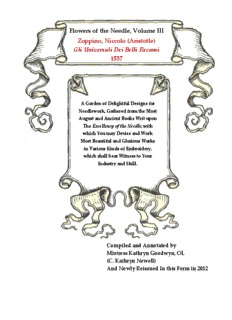
Flowers of the Needle, Volume III Zoppino, Niccolo (Aristotle) Gli PDF
Preview Flowers of the Needle, Volume III Zoppino, Niccolo (Aristotle) Gli
Flowers of the Needle, Volume III Zoppino, Niccolo (Aristotle) Gli Universali Dei Belli Recami 1537 A Garden of Delightful Designs for Needlework, Gathered from the Most August and Ancient Books Writ upon The Excellency of the Needle; with which You may Devise and Work Most Beautiful and Glorious Works in Various Kinds of Embroidery, which shall bear Witness to Your Industry and Skill. Compiled and Annotated by Mistress Kathryn Goodwyn, OL (C. Kathryn Newell) And Newly Reissued In this Form in 2012 Flowers of the Needle, Volume III Zoppino, Niccolo (Aristotle) Gli Universali Dei Belli Recami, 1537 INTRODUCTION Zoppino’s second book has a title that translates to “The Universals of Beautiful Embroidery…” The rest of the run-on title mentions that men or women may use the patterns. The book was published in 1537 and claims to contain patterns “never before published by anyone”. For the most part, these designs are not like the ones in his first book in this work, or Tagliente, so this claim may be true. Most of his short introduction is philosophical in nature, speaking of the nobility and virtue of knowledge, what it means to man, and how man expresses it. The implication of some of his text is that these patterns can be used for a variety of arts, including embroidery. The patterns start with a great variety of scrolling and foliate designs, fretwork, strapwork, and two Neo Classical-style panels. More scrolling patterns, “Moorish” designs, then two roundels follow. One is a peacock, which tends to stand for “Pride”. There is one with a pierced heart with what looks like a pair of “eyes” above it, weeping. The heart sits on top of a flame. Could this mean “burning love”? Between these two roundels is a surprisingly modern drawing of two hands entwined. Such a symbol has been used in the 19th century to indicate “friendship”. I am delighted to know this symbol dates back this far in cultural history. Soon after are some patterns which I have found to be fairly unique in needlework patterns. Instead of the stitches being indicated by a filled-in solid square, there is a solid dot inside a square. The patterns themselves are fairly difficult to see and chart. Countess Ianthé D’Averoigne (Kim Brody Salazar) charted these in her book “The New Carolingian Modelbook”. She admitted that these were difficult to chart. I am in the process of charting them for a future book, and agree as to the difficulty. http://www.flowersoftheneedle.com 2 Flowers of the Needle, Volume III Zoppino, Niccolo (Aristotle) Gli Universali Dei Belli Recami, 1537 Some more charted designs follow, including a delightful one of a rabbit and dog, sitting down as friends. They are surrounded by a border of heraldic-styled birds (eagles?) and lions, with small interlace knots. This would make a charming needle book or cushion cover. More charted designs follow, including a magnificent one of an eagle in a position which heraldry calls “displayed”. There is a brocaded pattern with “K”, “E” and S” inhabiting some small shield-shaped motifs. The pattern after that is another of those rare diagonally charted patterns. After that is a very handsome brocaded pattern that actually looks like a brocade. The motif is one I have heard referred to as “pomegranate”. I used this pattern to embroider a pillow top in red and black on white evenweave fabric. The result was quite splendid. Following a few more pages of charted patterns are some drawings which I assume were designs for cartoons for tapestries. The cartoons are drawings held in place behind the woven tapestry, serving as a guide. The one of the man and woman walking in a garden shows a typical turban (or “balzo”) headdress being worn by the lady. These headdresses, in this particular style, were in vogue in the 1530’s. Following this are putti, or little cupids, which were very popular in Italian art. The last few designs are more drawings, one of animals which includes a pair of leopards (?) and a monkey. Following that is one of a man and woman in an exotic looking, walled pleasure garden. The final designs show Orpheus taming animals with his singing, and a Neo Classical fountain with a pair of rabbits below. The book ends by mentioning the title and author again, as well as the publishing date. The tiny sketch accompanying this shows a bishop or possibly an archbishop, handing a plate of fruit (apples?) to a young woman (saint?). This small design shows up in another book in this work. It is difficult to know if this design was meant to indicate a patron, or whether the actual press was in the control of the Catholic Church. -Kathryn Goodwyn, 2011 http://www.flowersoftheneedle.com 3 Flowers of the Needle, Volume III Zoppino, Niccolo (Aristotle) Gli Universali Dei Belli Recami, 1537 http://www.flowersoftheneedle.com 4 Flowers of the Needle, Volume III Zoppino, Niccolo (Aristotle) Gli Universali Dei Belli Recami, 1537 http://www.flowersoftheneedle.com 5 Flowers of the Needle, Volume III Zoppino, Niccolo (Aristotle) Gli Universali Dei Belli Recami, 1537 http://www.flowersoftheneedle.com 6 Flowers of the Needle, Volume III Zoppino, Niccolo (Aristotle) Gli Universali Dei Belli Recami, 1537 http://www.flowersoftheneedle.com 7 Flowers of the Needle, Volume III Zoppino, Niccolo (Aristotle) Gli Universali Dei Belli Recami, 1537 http://www.flowersoftheneedle.com 8 Flowers of the Needle, Volume III Zoppino, Niccolo (Aristotle) Gli Universali Dei Belli Recami, 1537 http://www.flowersoftheneedle.com 9 Flowers of the Needle, Volume III Zoppino, Niccolo (Aristotle) Gli Universali Dei Belli Recami, 1537 http://www.flowersoftheneedle.com 10
Description: